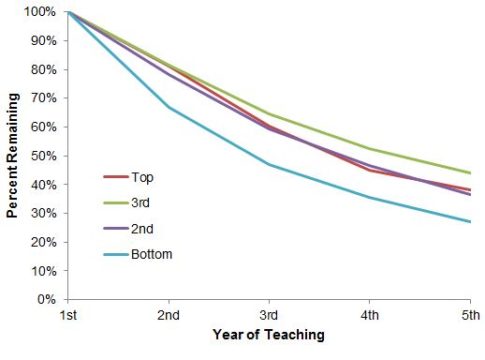Yesterday, a California superior court overturned five state laws related to the employment of teachers. The plaintiffs’ attorney called the decision “a victory for students, parents, and teachers across California.” The head of the Los Angeles teachers union said, “This decision today is an attack on teachers.” The court ordered a stay on the decision, pending an appeal. Here are ten things worth knowing as the case moves on.
1. The plaintiffs, a group of students and school districts, sued, arguing that several state statutes stood in the way of all students receiving the education guaranteed to them under the state constitution. “Plaintiffs claim that the Challenged Statutes result in grossly ineffective teachers obtaining and retaining permanent employment, and that these teachers are disproportionately situated in schools serving predominantly low-income and minority students. Plaintiffs’ equal protection claims assert that the Challenged Statutes violate their fundamental rights to equality of education by adversely affecting the quality of the education they are afforded by the state.”
2. The court agreed. It found “that the Challenged Statutes impose a real and appreciable impact on students’ fundamental right to equality of education and that they impose a disproportionate burden on poor and minority students.”
3. This was essentially a civil-rights case, and the court underscored that point by starting its opinion by referencing Brown vs. Board of Education and then quoting the famous passage that education “is a right which must be made available to all on equal terms.”
4. State courts have, in recent years, regularly intervened in public education by requiring that state governments more “equitably” or “adequately” fund schools. This decision references several previous California cases related to money, including the Serrano decision, which found that “the then-existing school finance system to be a violation of the equal protection clause of the California Constitution.”
5. This case is different because a court has decided that it’s not only unfair funding statutes that can render a public education system unconstitutionally discriminatory and unjust: unfair education statutes of other types, including employment laws, can be overturned for the same reason. The court made this clear by noting that it’s not just money that matters but also what happens in the classroom. “This Court is directly faced with issues that compel it to apply these constitutional principles to the quality of the educational experience.” (Emphasis added.)
6. Like just about every groundbreaking decision, this one includes dramatic language to make its point (and likely help sustain the decision on appeal). “Evidence has been elicited in this trial of the specific effect of grossly ineffective teachers on students. The evidence is compelling. Indeed, it shocks the conscience.”
7. The court described one of the overturned statutes as “bizarre,” noting that it could leave an “applicable district with a non-credentialed teacher with tenure.” This law did not “provide nearly enough time for an informed decision to be made regarding the decision of tenure…both students and teachers are unfairly, unnecessarily, and for no legally cognizable reason (let alone a compelling one), disadvantaged by the current Permanent Employment Statute.” Importantly, the court was moved by the fact that the statute forced districts to part ways with some new teachers if they had any doubt of the teachers’ effectiveness; districts don’t want to take any chances because later removal of a tenured teacher is so difficult.
8. The court was convinced that the time and cost required to remove an ineffective educator was fundamentally unfair to students. “The evidence this court heard was that it could take anywhere from two to almost ten years and cost $50,000 to $450,000 or more to bring these cases to conclusion under the Dismissal Statutes, and that given these facts, grossly ineffective teachers are being left in the classroom.” Interestingly, a defense witness conceded that between 1 and 3 percent of teachers in the state are “grossly ineffective.” The court noted that this amounted to as many as 8,000 teachers having “a direct, real, appreciable, and negative impact” on students.
9. The court also overturned LIFO (last-in first-out) rules, which govern layoff and re-staffing decisions. “The lack of effective dismissal statutes and LIFO affect high-poverty and minority students disproportionately.”
10. Early reaction from major players include the following: The New York Times called Vergara “a decision that hands teachers’ unions a major defeat in a landmark case.” The Washington Post reported that the court decided “tenure, seniority and other job protections for teachers have created unequal conditions in public schools and deprive poor children of the best teachers.” Secretary of Education Arne Duncan issued a subdued statement noting that the plaintiffs are “just nine out of millions of young people in America who are disadvantaged by laws, practices and systems that fail to identify and support our best teachers and match them with our neediest student.” He hopes “today’s decision moves from the courtroom toward a collaborative process in California that is fair, thoughtful, practical and swift.” AFT president Randi Weingarten tweeted, “Sad day in Cali- but not unexpected that lower court would find that for students to win, teachers have to lose.”
-Andy Smarick
This first appeared on the Fordham Institute’s Flypaper blog.



